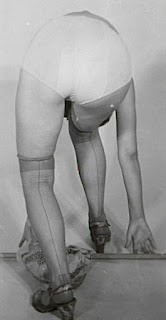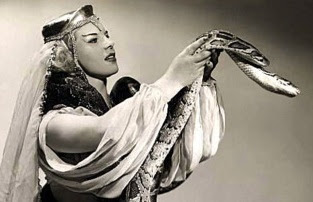There were
thousands of anonymous women working in the smut business. Here is just
one of many, and her tale represents all. An unfinished portrait of
Lilly La Mont, slightly gap-toothed Half-Native American stripper,
prostitute, model and B-girl from the 1950s. A heavy drinker with
mystery nicknames who "packed them into a Greenwich Village nightclub
for not for long..." A woman I hope to put a real name to, and
representing a thousand hard-working young women in a far from glamorous
industry. Despite the retro resurgence of "pin-up culture" and
so-called "glamour" photography, these sexual pioneers and independent
woman would have a few things to say about glamour. Living out of
trunks, at the mercy of crooked theater owners, working for pennies in
smoke and alcohol-drenched spaces in front of drunken, hormonal, often
desperate men? Show business.
Lilly is today a
cypher and ghost pinup, but one who was likely the first muse for
"Faster, Pussycat! Kill Kill" film maker Russ Meyer, who found, lost and
never quite got over her. All the model left behind is a few stag
films, some portrait fragments, a publicity still or two, a magazine
cover which inspired a tattoo artist 50 years later and the scarce
mail-order brochures shown here.
Lilly La Mont,
real name unknown, was referred to as "The Alaskan Heat Wave" in Time
Magazine, yet whether she ever stepped foot in the 49th state is
unknown. She did perform with a dead polar bear on stage. At one time,
as she was stripping in a Portland, Oregon club called Star Burlesque
(where she turned tricks on the side) Lilly would put on a regular
private show for a wealthy patron who had her dance nude as he lay in a
coffin watching, a story she shared with Russ Meyer who used it as the
opening for his film "Beneath the Valley of the Ultra Vixens" 25 years
after she told him the story.

Lilly appeared in
the legendary "lost" film Meyer made for the owner of the El Ray
Burlesque Theater in 1950, a pseudo-documentary known variously as
"French Peep Show" or "French Postcards" which preceded what is
generally understood as Meyer's first proper (improper) film "The
Immoral Mr. Teas." In a Time magazine article about the trend in "nudie"
pictures, La Mont is described by Meyer as having "a socko twin pair of
casabas with corralling-cleavage capable of hiding Johnny Bench's
catcher's mitt." The phrase also appears in Meyer's massive three volume
autobiography "A Clean Breast" still in print ten years after the
master's death and still giving the Fedex man a hernia.
"French Peep
Show" was a vehicle for bombshell burlesque queen Tempest Storm, but
Lilly played bit part showing her parts. Her name follows Tempest's on
the poster. Interestingly, French Peep Show may have also spotlighted
another disappearing beauty, Dawn Danielle, profiled here later. (Whose
actual fake name was Dawn Denielle.)
A year after
Meyer filmed Lilly the "pneumatic terper" he found her again and
convinced her to pose for some nude shots. One suspects it wasn't too
difficult, as she immediately asked for lotion to shine up her breasts
and later posed for a splendid self-portrait (with timer) of the two.
Meyer rests his head on her breasts. It is one of the few self-portraits
Meyer put in his book. He also commissioned cartoonist Bill Ward to
illustrate her coffin story.

A few years
earlier...(or later?) Lilly somehow landed a continuing role on a CBS
radio show called "Hollywood Madness" where she met met George
Tirebiter, B movie film director. She married him for a short time, but
the divorce came after he supposedly dated Marilyn Monroe. In 1950 it is
reported she turned him in during the communist witch hunt to save her
own lovely skin, and appeared in the film "Yesterday's Sunset" as Baby
Heather, a former dancer. No stretch. The film was a moderate success,
earning a nomination or two for Academy awards but certainly none for
Lilly.
Dancer Dixie
Evans remembers finding Lilly years later in Providence, Rhode Island.
In Jimmy McDonough's "Big Bosoms and Square Jaws" she laments La Mont's
disappearance. "She was staying at this cheap broken-down hotel..." and
recalls both on their way to "entertain" the governor of New York and
his friends. They had requested Lilly after seeing her on a burlesque
poster. Evans says Lilly could hardly drive ten miles without stopping
for a drink.
Later Lilly was
reported living in a bungalow at the El Encanto Hotel, where she may
have spent her remaining days in a drunken haze.
Some sources have
Lilly dancing as early as the 1930s, and yet she appeared on the cover
of the French "Follies De Paris Hollywood" pictorial pinup magazine in
1952, and our phantom beauty is referred to as "the most explosive girl
in Canada" at the time. This image of Lilly was turned into a piece of
contemporary art 40 years later by Mexican tattoo artist Jeronimo Lopez
Ramirez, who works under the name of Dr. Lakra. In a striking piece (and
inadvertent tribute to a woman who was surely anonymous to the artist)
Dr. Lakra covered a pinup of La Mont with intricate ink designs, a piece
which was exhibited at the Musem of Modern Art.
Here the story ends. One internet site desperately asks for more information.
We can only hope
Miss Lilly La Mont did not end up like another of Meyer's prominent
models, the lovely Yvette Vickers, whose mummified body was found a year
after her death in 2011 by a woman who found cobwebs across her front
door. Vickers was one of Meyer's three Playboy centerfolds in 1959.
Lilly La Mont Mystery of the Alaskan Heat Wave is by
Jim Linderman
Do not reproduce without permission.
Linderman's books and ebooks are available
HERE at Blurb and Dull Tool Dim Bulb Books
Folies de Paris et de Hollywood Magazine Collection Victor Minx
"Lady Bountiful" brochure Collection Jim Linderman















































